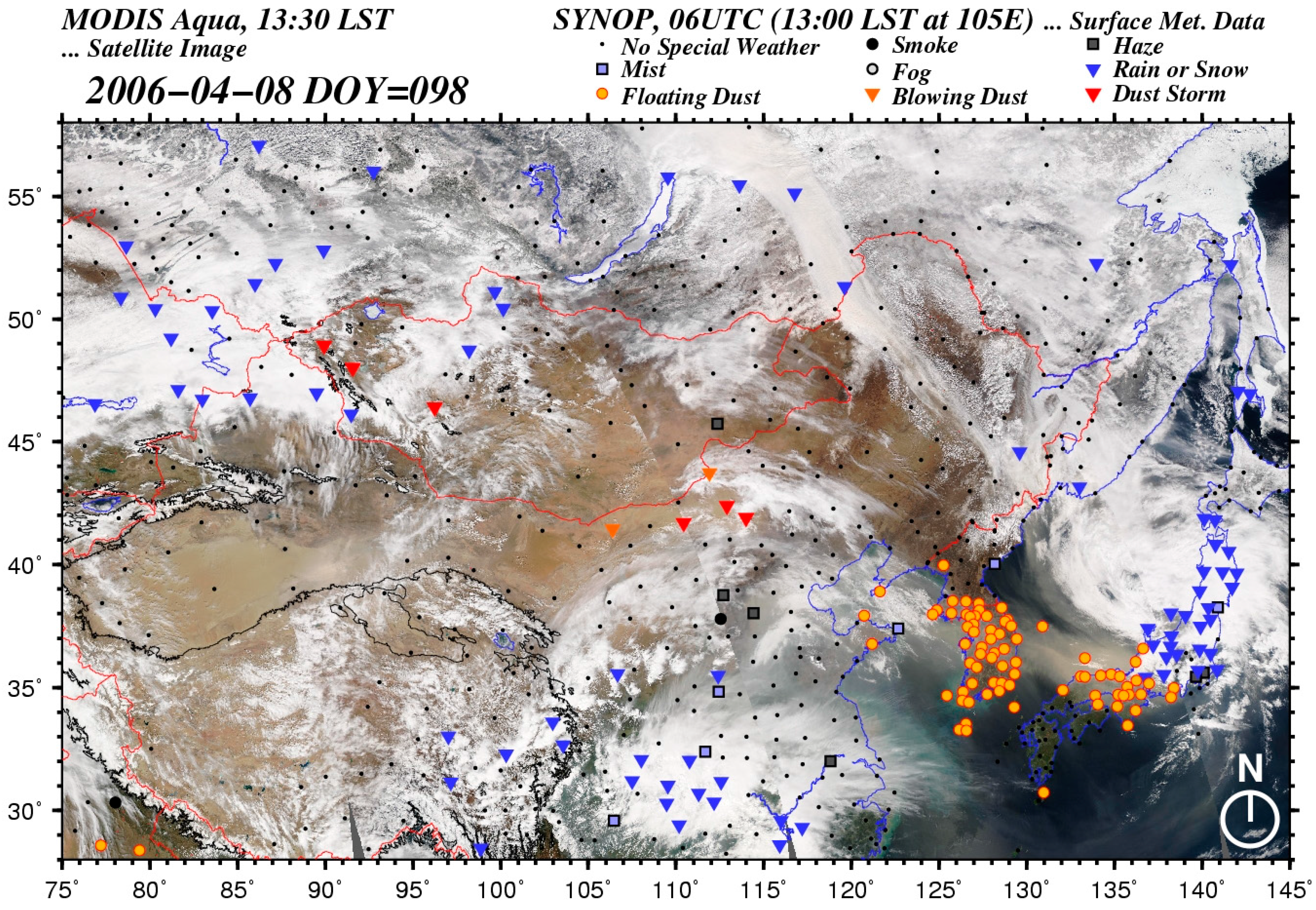Dust Storms from Degraded Drylands of Asia: Dynamics and Health Impacts
Abstract
:1. Introduction
2. Impacts of Asian Dust on Health in Emission Regions
3. Impacts of Asian Dust on Health in Downwind Regions
4. Allergic Reactions and Asian Dust in Downwind Regions
5. Conclusions
Acknowledgments
Author Contributions
Conflicts of Interest
References
- Goudie, A.S. Desert dust and human health disorders. Environ. Int. 2014, 63, 101–113. [Google Scholar] [CrossRef] [PubMed]
- Karanasiou, A.; Moreno, N.; Moreno, T.; Viana, M.; de Leeuw, F.; Querol, X. Health effects from Sahara dust episodes in Europe: Literature review and research gaps. Environ. Int. 2012, 47, 107–114. [Google Scholar] [CrossRef] [PubMed]
- Kurosaki, Y.; Mikami, M. Regional Difference in the Characteristic of Dust Event in East Asia: Relationship among Dust Outbreak, Surface Wind, and Land Surface Condition. J. Meteorol. Soc. Jpn. 2005, 83A, 1–18. [Google Scholar] [CrossRef]
- Dulam, J. Discriminate Analysis for Dust Storm Prediction in the Gobi and Steppe Regions in Mongolia. Water Air Soil Pollut. Focus 2005, 5, 37–49. [Google Scholar] [CrossRef]
- Mu, H.; Battsetseg, B.; Ito, T.Y.; Otani, S.; Onishi, K.; Kurozawa, Y. Health effects of dust storms: Subjective eye and respiratory system symptoms in inhabitants in Mongolia. J. Environ. Health 2011, 73, 18–20. [Google Scholar] [PubMed]
- Mu, H.; Otani, S.; Shinoda, M.; Yokoyama, Y.; Onishi, K.; Hosoda, T.; Okamoto, M.; Kurozawa, Y. Long-term effects of livestock loss caused by dust storm on mongolian inhabitants: A survey 1 year after the dust storm. Yonago Acta Med. 2013, 56, 39–42. [Google Scholar] [PubMed]
- State Implementing Agency of Health, Government of Mongolia. Health Indicators 2011; State Implementing Agency of Health: Ulaanbaatar, Mongolia, 2012; p. 96. [Google Scholar]
- Onishi, K.; Kurosaki, Y.; Otani, S.; Yoshida, A.; Sugimoto, N.; Kurozawa, Y. Atmospheric transport route determines components of Asian dust and health effects in Japan. Atmos. Environ. 2012, 49, 94–102. [Google Scholar] [CrossRef]
- Maki, T.; Kurosaki, Y.; Onishi, K.; Lee, K.C.; Pointing, S.B.; Jugder, D.; Yamanaka, N.; Hasegawa, H.; Shinoda, M. Variations in the structure of airborne bacterial communities in Tsogt-Ovoo of Gobi desert area during dust events. Air Qual. Atmos. Health 2017, 10, 249–260. [Google Scholar] [CrossRef] [PubMed]
- Maki, T.; Puspitasari, F.; Hara, K.; Yamada, M.; Kobayashi, F.; Hasegawa, H.; Iwasaka, Y. Variations in the structure of airborne bacterial communities in a downwind area during an Asian dust (Kosa) event. Sci. Total Environ. 2014, 488–489, 75–84. [Google Scholar] [CrossRef] [PubMed]
- Shepherd, G.; Terradellas, E.; Baklanov, A.; Kang, U.; Sprigg, K.A.; Nickovic, S.; Boloorani, A.D.; Al-Dousari, A.; Basart, S.; Benedetti, A.; et al. Global Assessment of Sand and Dust Storms; United Nations Environment Programme (UNEP): Nairobi, Kenya, 2016; pp. 40–42. ISBN 978-92-807-3551-2. [Google Scholar]
- Kanatani, K.T.; Ito, I.; Al-Delaimy, W.K.; Adachi, Y.; Mathews, W.C.; Ramsdell, J.W.; Toyama Asian Desert Dust and Asthma Study Team. Desert dust exposure is associated with increased risk of asthma hospitalization in children. Am. J. Respir. Crit. Care Med. 2010, 182, 1475–1481. [Google Scholar] [CrossRef] [PubMed]
- Watanabe, M.; Yamasaki, A.; Burioka, N.; Kurai, J.; Yoneda, K.; Yoshida, A.; Igishi, T.; Fukuoka, Y.; Nakamoto, M.; Takeuchi, H.; et al. Correlation between Asian dust storms and worsening asthma in Western Japan. Allergol. Int. 2011, 60, 267–275. [Google Scholar] [CrossRef] [PubMed]
- Matsukawa, R.; Michikawa, T.; Ueda, K.; Nitta, H.; Kawasaki, T.; Tashiro, H.; Mohri, M.; Yamamoto, Y. Desert dust is a risk factor for the incidence of acute myocardial infarction in Western Japan. Circ. Cardiovasc. Qual. Outcomes 2014, 7, 743–748. [Google Scholar] [CrossRef] [PubMed]
- Otani, S.; Onishi, K.; Mu, H.; Kurozawa, Y. The effect of Asian dust events on the daily symptoms in Yonago, Japan: A pilot study on healthy subjects. Arch. Environ. Occup. Health 2011, 66, 43–46. [Google Scholar] [CrossRef] [PubMed]
- Otani, S.; Onishi, K.; Mu, H.; Yokoyama, Y.; Hosoda, T.; Okamoto, M.; Kurozawa, Y. The Relationship between Skin Symptoms and Allergic Reactions to Asian Dust. Int. J. Environ. Res. Public Health 2012, 9, 4606–4614. [Google Scholar] [CrossRef] [PubMed]
- Onishi, K.; Otani, S.; Yoshida, A.; Mu, H.; Kurozawa, Y. Adverse health effects of Asian dust particles and heavy metals in Japan. Asia Pac. J. Public Health 2015, 27, 1719–1726. [Google Scholar] [CrossRef] [PubMed]
- Oh, S.Y.; Fong, J.J.; Park, M.S.; Chang, L.; Lim, Y.W. Identifying airborne fungi in Seoul, Korea using metagenomics. J. Microbiol. 2014, 52, 465–472. [Google Scholar] [CrossRef] [PubMed]
- Otani, S.; Onishi, K.; Mu, H.; Hosoda, T.; Kurozawa, Y.; Ikeguchi, M. Associations between subjective symptoms and serum immunoglobulin E levels during Asian dust events. Int. J. Environ. Res. Public Health 2014, 11, 7636–7641. [Google Scholar] [CrossRef] [PubMed]


© 2017 by the authors. Licensee MDPI, Basel, Switzerland. This article is an open access article distributed under the terms and conditions of the Creative Commons Attribution (CC BY) license (http://creativecommons.org/licenses/by/4.0/).
Share and Cite
Otani, S.; Kurosaki, Y.; Kurozawa, Y.; Shinoda, M. Dust Storms from Degraded Drylands of Asia: Dynamics and Health Impacts. Land 2017, 6, 83. https://doi.org/10.3390/land6040083
Otani S, Kurosaki Y, Kurozawa Y, Shinoda M. Dust Storms from Degraded Drylands of Asia: Dynamics and Health Impacts. Land. 2017; 6(4):83. https://doi.org/10.3390/land6040083
Chicago/Turabian StyleOtani, Shinji, Yasunori Kurosaki, Youichi Kurozawa, and Masato Shinoda. 2017. "Dust Storms from Degraded Drylands of Asia: Dynamics and Health Impacts" Land 6, no. 4: 83. https://doi.org/10.3390/land6040083



